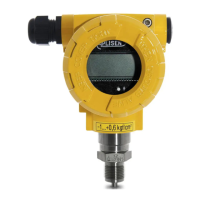E6 39 DTR.APC.APR.ALW.03(ENG)
8.2. APR... Installation and connections
8.2.1. The APR … transmitters can be mounted directly on rigid impulse lines.
To connect the transmitter basic versions, with two M20 x 1.5 connectors (P-type connector), can use
(for example) straight connecting elements with C type nuts. If elastic impulse lines are used, the transmitter
should be additionally fastened to a pipe, panel or supporting construction.
8.2.2. The APR-2000ALW and APR-2200ALW can be installed using the ø25 Fastener (Fig.12) on an ø25 pipe
or on a flat surface using an angle bracket.
8.2.3. The APR-2000ALW with connecting cover (C-type connector) (Fig.10) are designed for installation on 3-
valve or 5-valve manifolds to a 2” pipe or to a flat surface using “C-2” holder (Fig.13, Fig.14).
8.3. APR-2000GALW. Installation and connections
8.3.1. The “economy” version of the APR-2000GALW transmitter can be mounted on a wall, panel or other
stable construction, using a clamp with Ø9 holes (Fig.18). The transmitter is fitted with connectors which fit to
an Ø6x1 elastic impulse tube. When the measuring impulse is transmitted via a metal terminal with M20x1.5
connector, an adapter is used between the M20 x 1.5 threads and the Ø6x1 terminal.
Transmitters should be installed in a vertical position. The way of impulse line leading should enable
the vapour flowing towards the pipeline. Where there is a significant difference between the height at which
the transmitter is mounted and the height of the impulse source, particularly if the measurement range is small,
the reading may fluctuate depending on the temperature difference between the impulse lines. This effect can
be reduced by ensuring that the impulse lines run side by side.
8.3.2. The APR-2000GALW transmitter can also be fitted with an adapter (Fig.18) creating a C-type connector,
designed for installation on a 3-valve or 5-valve manifold. Aplisens can also supply ready transmitters mounted
on valves.
8.4. APR-2000YALW. Installation and connections
The APR-2000YALW level probes installed in places where liquid levels are measured in closed tanks, with
access to medium from top of tank as Fig.19 and 10.2.9. Level probes should be installed in a vertical position.
8.5. APC-2000ALW/L…. Installation and connections
APC-2000ALW/L…. installed in places where liquid level is measurement: in wells, tanks, reservoirs, etc.
The transmitter sensor is immersed in measured medium. The sensor can be hung on the power cable by using
a Aplisens SG handle , but especially in the case of long cables, or if are opportunities of hooking protruding
elements when the cable is pulling up, it is recommended that the sensor suspended on a steel rope using the
sensor lug. If the sensor would be in the flow or turbulence of medium, should be assembled in the casing pipe
for example PVC made.
8.6. APR-2200ALW/D Installation and connections
The welded flange DN100 PN40 is provided to mount the APC-2000ALW/D density transmitter on a pressure
tank. The location of the device working part at appropriate depth is possible with the Ø27 tube having the
length “L”, depending on a purchaser’s order (Fig.24).
The density transmitter can be mounted on an atmospheric pressure tank with any fastener for the Ø27 tube,
but the vertical position of assembly must be kept. The minimum diameter of the mounting hole is 108 mm.
From sensor SG-25S remove the protective plate before it’s placing into medium.
During the installation the sensor should be protected from mechanical shocks.
Sensor with cable with additional Teflon shield should be hung on steel rope or on a cable (no fasten by
Teflon shield).
Pressure may be transmitted to the installed device only after checking that it has a measurement
range which properly corresponds to the value of the measured pressure, that gaskets have been
properly selected and fitted, and the connectors have been properly screwed tight.
Attempts to undo the screws or fixing connector pipes on a transmitter under pressure may
cause the medium to leak and create hazards for the personnel.
When disassembling the transmitter, it is necessary to disconnect it from the process pressure or
bring the pressure to atmospheric level, and to take particular care and precautions in case of
media which are highly reactive, caustic, explosive or otherwise hazardous to personnel.
If necessary, rinse out this part of the system.

